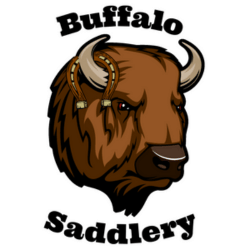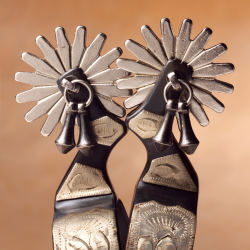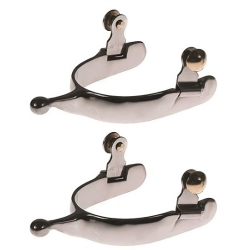An Introduction to Reining: History, Movements, and Equipment
Las Vegas: September, 2015.
By Dan Chow.
This is the Highroller Reining Championships. The arena, brightly lit by a half dozen spotlights and a glaring Jumbotron, is aglow with excitement. A single rider, her brightly colored costume on fire with reflected light, straddles a glittering reining saddle festooned with silver accents. An anxious family, bubbling over with anticipation, sends a stream of whistling encouragement over the side rail and across the carefully raked arena floor. Then, plumes of dust erupt as the reining contestant urges her mount forward in a sudden burst of speed. Soon after reaching a gallop, she leans back in her show saddle as the horse plants his hind legs, and the rider is brought to a gliding stop in a roiling dust cloud. With surprising grace, the pair wheel around as one, and continue on with their exhibition in the opposite direction. This movement, the Sliding Stop and Rollback, is just one of the cornerstone maneuvers common in modern day Reining.
With all the pageantry of modern day Reining, it would be easy to overlook this sport’s historical anchor as a practical exercise, or to become overwhelmed by the myriad of different movements, show saddles, tack, and costume options available to the aspiring Reiner. But do not despair! As an introduction to Reining, this article gives you the information you need to get on your way. Let’s start with the history of Reining.
The core of Reining is the rider’s ability to communicate with their horse subtlely, and to have their horse follow a gentle lead. A slight flick of the reins or small shift in the show saddle is all that is needed to bring a well trained mount to a gallop, or into a spin. Reining is the melding of minds between horse and rider; if you could communicate telepathically with your horse, you would exemplify the foundation of Reining! But for those of us without telepathic powers: patient training, a good show saddle, appropriate show tack, and a can-do attitude are required. Reining did not start off as a competitive sport, or as any kind of sport at all! Like so many equestrian sports, it is the offspring of necessity and bravado!
Cowboys often need to use both hands, while mounted, to wrangle cattle. Whether handling a lariat or a rifle, cowboys depend on their horses to respond to gentle flank tapping or weight shifts in the saddle as the sole form of communication between rider and mount. Another historical example of a rider needing to communicate with their mounts without a strong hand on the reins is the horseback archer. For obvious reasons, the horseback archer is unable to use the reins to guide their horse, and depends on the horse’s breeding, instincts, and training to obey a rider who has their hands full. Of course, anytime a group of people have a skill in doing something interesting or difficult, it naturally becomes a competition! From these informal demonstrations for bragging rights, the western competitive sport of reining was born. Today, the sport is formally regulated by equestrian sports authorities such as the National Reining Horse Association (NRHA). Each competition features riders demonstrating a choreographed series of movements who are graded in a systematic fashion.
Movements are to reining what steps are to dancing. Each rider in a competition performs the same set of movements, and their performance is graded according to a standard. Because western reining is based on the ability of a rider to guide a horse with little encouragement, they depend on subtle taps with their spurs, or shifting weight in their show saddles. Here are some of the core movements in national reining competitions:
- Large, Fast Circles: The rider guides the horse in a large circle. The pace should be quick, but with the horse still at a lope. The circle should be perfectly round, and the rider should lean forward in his western show saddle, and give the horse his head. As with all reining movements, the horse should go through the motion willingly, without any noticeable handling by the rider.
- Small, Slow Circles: The rider guides the horse in a small circle, typically half the size of the large circle. The circle should be perfectly round, and the rider should lean forward in his western saddle to give the horse its head. The pace should be slow, almost to a trot, but still a lope. Judges will be looking for a noticeable difference in both the size and shape of the large and slow circles.
- Spins: From a standstill, the rider guids the horse into a spin. The horse should pivot around its inside hind leg. The rider should remain upright in the show saddle, without leaning. The horse should complete the motion willingly, with little prompting. Often, riders will turn slightly in their western saddle while tapping on the inside flank. Judges will award high marks for a tight spin that is done in place, at a consistent speed, that ends in the same orientation.
- Pause: A momentary pause or “wait” between movements. The judges are looking for a settled and calm horse. If the horse seems impatient or restless, points will be deducted.
- Rundown: The rider brings the horse up to a gallop down the long side of the arena. This is a great opportunity to demonstrate the power of the mount, and to ride with fluid grace for the judges. The rundown typically precedes the Sliding Stop.
- Sliding Stop: From a gallop, the horse is made to come to a sliding stop by planting its hind legs, and ‘squatting’ on its hindquarters while continuing to walk forward with its front feet. This is easily the most entertaining movement to observe. When it is properly executed, it produces a large dust cloud that billows out in front of the horse and rider. Because of the sudden change in momentum, the rider has to lean back in her show saddle, and brace against the stirrups. The Sliding Stop is followed by the Rollback.
- Rollback: From the Sliding Stop, the horse immediately pivots on its hind legs 180 degrees and emerges in a lope. The judges will be watching for a smooth rotation, free from hesitation. This movement originates from the need for agility in western stock horses. It is important in wrangling for stock horses to be able to abruptly stop and change direction with speed compared other horses.
- Backup: From a stop, the horse is made to walk backwards at least 10 feet. Judges watch for a quick backup pace, a straight line, and minimal prompting from the rider.
- Simple Lead Change: The rider brings the horse to a trot, and then prompts the mount to change leading legs. This is often done when moving from one circle to another.
- Flying Lead Change: The horse is asked to change his leading leg mid canter. This is more difficult and requires a trained and disciplined horse. The skilled rider can accomplish this with only subtle cues, such as shifting weight or leg positioning in the western saddle. The trained horse will know to change leads when switching from clockwise to counterclockwise circles and may not need prompting.
Show and Reining Saddles and equipment should be chosen based on a number of important criteria.
Firstly, the western reining show saddle should have long stirrups for mobility in the seat. A long reach will help to maintain a low center of gravity during the sliding stop and roundback. A good show saddle for reining will also have light, thin fenders so that any signals from the riders knees are transmitted through the leather to the horse. A tall horn will provide increased stability and control while riding. Because reining is a show sport, and let’s face it, we all like to see a little sparkle at show time, western show saddles for reining come with lots of pretty bling. Here are some examples of totally decked out, blingin’ show saddles. (images pulled from TexanSaddles.com)
Spurs are permitted, and there are many beautiful, showy spurs that go great with show attire. The type of spur depends greatly on the rider’s style and the sensitivity of the horse.
There are regulations regarding the kind of bits that can be used during competition. The NRHA handbook provides exact diagrams of bit regulations. You can find a complete copy of the NRHA handbook at http://nrha1.com/media/pdf/handbook/2015/handbook.pdf.
Well, there you go! A quick primer on the wondrous world of Reining. Reining is included at prestigious events such as the National Finals Rodeo, held in Las Vegas, Nevada since 1985.












































